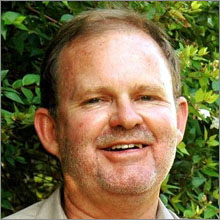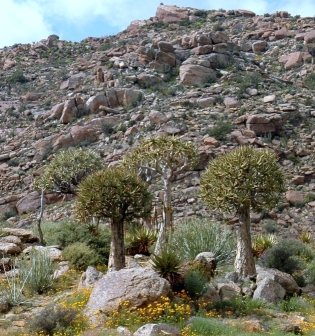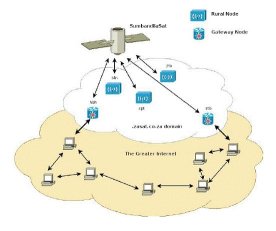SAEON prepares to generate more comprehensive observation data
|
“It will be crucial to strike the right balance between funding for space-based Earth Observation and in situ Earth Observation to avoid competition and promote collaboration and integration, hence a stakeholder-based regulator may be required” – Johan Pauw, Head of SAEON |
|
An agreement has been signed with SANParks to host the new SAEON Node for Arid Lands which will be established at Kimberley (Picture © Johan Pauw) |
|
SumbandilaSat is a South African micro satellite which will be launched in the near future. What is significant about this satellite is that it is only the second satellite to be made in South Africa that will be launched into space. This South African scientific event represents a R26 million investment into its space programme. SumbandilaSat is part of a closely integrated South African space programme, which will serve as a research tool to investigate the viability of affordable space technology. Furthermore, the satellite will monitor and manage amongst others, disasters such as desertification, flooding, oil spills and fires within Southern Africa. This particular satellite has capabilities optimised for agricultural applications (Illustration © Gert-Jan van Rooyen) |
It is with great pleasure that we announce the signing of a new hosting agreement between SAEON and SANParks. This replaces the original hosting agreement which was for the SAEON Ndlovu Node only.
The new agreement allows for an unlimited number of nodes to be established in collaboration with SANParks. However, for the near future there will only be two such nodes, namely the existing SAEON Ndlovu Node at the Phalaborwa Access gate to the Kruger National Park and the Greater Limpopo Transfrontier Park, and the new node for Arid Lands which will be established at Kimberley. Whereas SAEON Ndlovu Node is a going concern, it is now a priority to accelerate the roll-out of the node for Arid Lands.
The location of the new node at Kimberley in association with SANParks follows the broad consultative process that SAEON has run in collaboration with the Arid Zone Ecology Forum (AZEF). The node is being established with the assistance of the staff of Scientific Services in SANParks, namely Hugo Bezuidenhout, Danie Pienaar and Stephanie Freitag. The first step will be the recruitment of a node manager, and it will also be necessary to construct office, educational and laboratory infrastructure in Kimberley.
National Global Change Science Plan
The issue of global climate change is of course wide-ranging and important and requires multi-disciplinary and multi-institutional teamwork to be comprehensively addressed. To this end the Department of Science and Technology (DST) is developing a National Global Change Science Plan.
SAEON is involved in this effort due to its primary interest in change measurement, vulnerability assessment, predictive capacity, adaptation to change, scientific capacity development and archiving/sharing of data. Clearly there must be a specific focus on climate change and by way of directly contributing to the existing knowledge base, a few projects have been initiated by the SAEON Ndlovu and Elwandle Nodes. More projects will follow, also at the other nodes.
SAEON postdoctoral fellowships
SAEON receives only core funding from the DST and can therefore not establish its own research teams. Instead, postdoctoral fellowships are being awarded for the achievement of specific SAEON objectives.
SAEON Egagasini has recently awarded a fellowship in physical oceanography in collaboration with Prof Johann Lutjeharms of the University of Cape Town (UCT). SAEON Ndlovu Node is starting up two new fellowships, whereas SAEON Elwandle Node’s two postdoctoral fellows have already produced great work and publications for SAEON.
Space Science and Technology Strategy
SAEON was recently privileged to have been given the opportunity to make a presentation to the international review panel for the DST’s new Space Science and Technology Strategy. Of relevance here is SAEON’s use of and contribution to space-based observations, as the strategy plans to continue the embryonic SumbadilaSat programme through the soon-to-be established Space Agency.
SAEON made the following points:
- An SA Earth Observation satellite will improve imagery and the accessibility thereof
- The pertinent advantages of satellite imagery are the spatial scale and frequency of observations
- The major limitation of satellite imagery is its inability to observe complexity
- SAEON has a key role in the South African Earth Observation Strategy (SAEOS) data & portal
- SAEON is a user and interpreter of space-based Earth Observation
- Space S&T per se is neither a competency nor the mandate of SAEON
- Satellite imagery is a tool of Earth Observation, i.e. it is more a technology to illustrate science and would be of limited scientific use in the absence of in situ observations
- The proposed societal benefits of the Space S&T Strategy cannot be realised in the absence of in situ observations (e.g. ‘Understanding, monitoring, and conserving biodiversity’)
- SAEON improves the ability to:
-
- ground-truth/calibrate/quantify satellite imagery
- interpret satellite imagery in the context of complexity
- access in situ information
- determine priorities
- It will be crucial to strike the right balance between funding for space-based Earth Observation and in situ Earth Observation to avoid competition and promote collaboration and integration, hence a stakeholder-based regulator may be required
This exercise and the subsequent DST workshop on Earth Observation required of SAEON to emphasize the importance of ongoing surface-level observations. It would be easy for the glamour of space high technology to dominate basic question-driven science in the eyes of the technocrats.
SAEON Data Portal gains ground
SAEON and its partners, the CSIR and the Department of Minerals and Energy have been working non-stop on the further development of the South African Integrated Spatial Information System (SAISIS). The objective is to become a comprehensive open access data management and data sharing system for environmental data that are mainly based on open source.
This work has now found wider application in that the DST has decided to use the SAEON portal as the basis of SAEOS. This development will hopefully provide a new impetus to the development of the system.
SAEON is certainly pleased that its efforts are hereby recognised as important and influential contributions to the National System of Innovation – for the benefit of our country and its people.
Article by Johan Pauw, Head of SAEON













